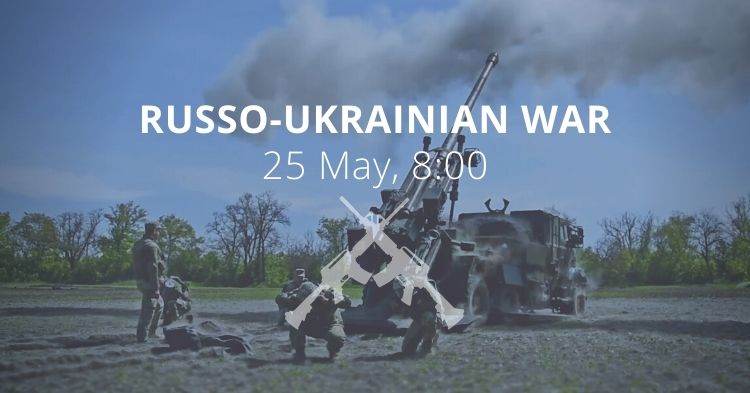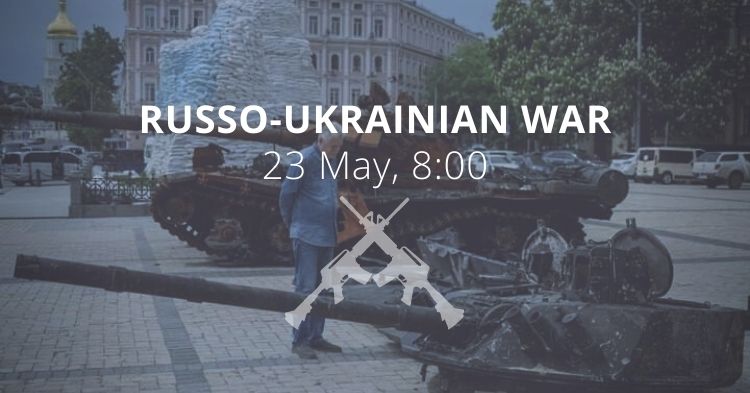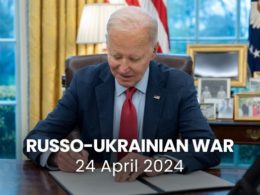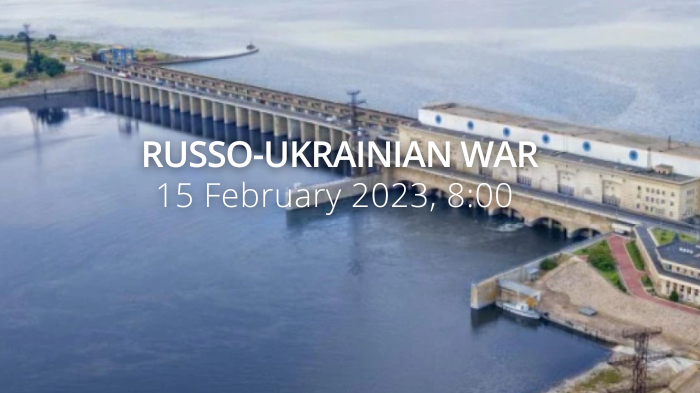Situation
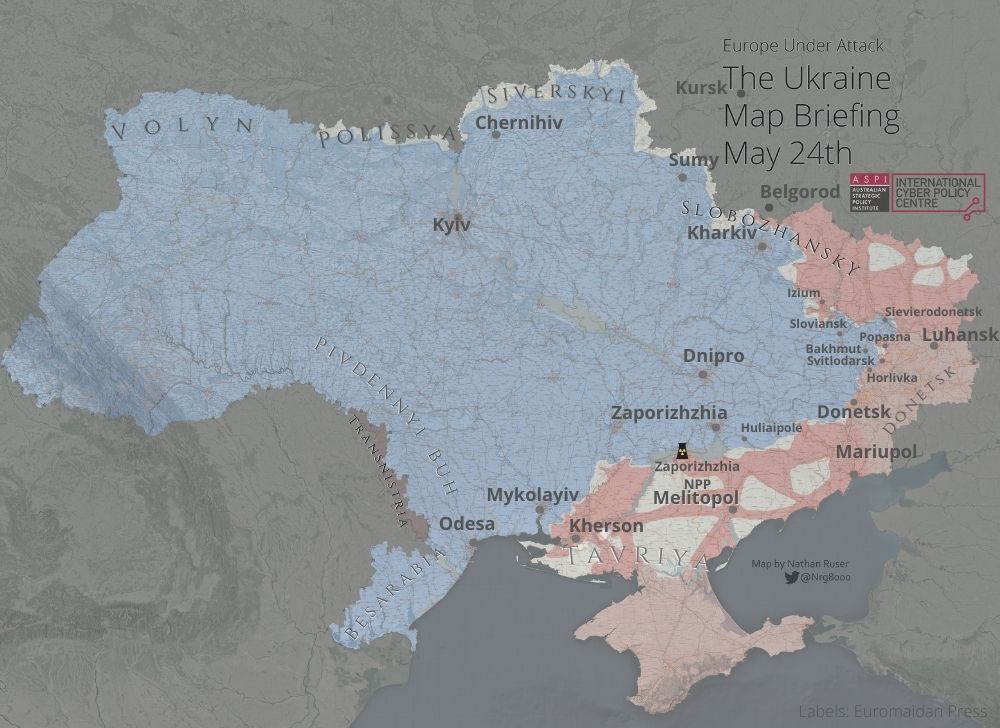
A short overview of developments at the front as of the evening of 24 May 2022 according to military expert Roman Ponomarenko:
The battle for the Donbas is underway, where Putin has deployed a lot of forces.
In Luhansk Oblast alone, the Russians have 25 battalion-tactical groups (20,000 soldiers) and according to President Zelenskyy’s May 23 statement, they have “20 times more equipment” in the Donbas than the Armed Forces of Ukraine.
Despite the difficult situation at the front, Zelenskyy said on 24 May that “Ukraine will sit down at the negotiating table with Russia after regaining our territories lost since February 24, when the war began.” Meanwhile, Ukraine’s intelligence chief Kyrylo Budanov stated that by the end of the year the Ukrainian armed forces should enter the territory of Crimea.
Local battles continued in Kharkiv Oblast in the area of Lyptsi, Ternova, and Rubizhne.
In Donetsk Oblast, the battle for Lyman continued east of Sloviansk, and to its north the one on the outskirts of Sviatohirsk. There were no special details from the Ukrainian side yet, while Russians claimed to have captured half of Lyman.
To cut off the government-controlled part of Luhansk Oblast, the Russian forces advance to Bakhmut and Soledar. Getting as close as about 20 kilometers to Bakhmut, they now can reach it with artillery fire. The battles are ongoing for Pylypchatyne. According to the Ukrainian General Staff, Russian troops were advancing in the area of Bilohorivka, which lies on the Bakhmut-Lysychansk highway. At the same time, Luhansk Oblast head Serhiy Haidai said that the highway remains under Ukrainian control.
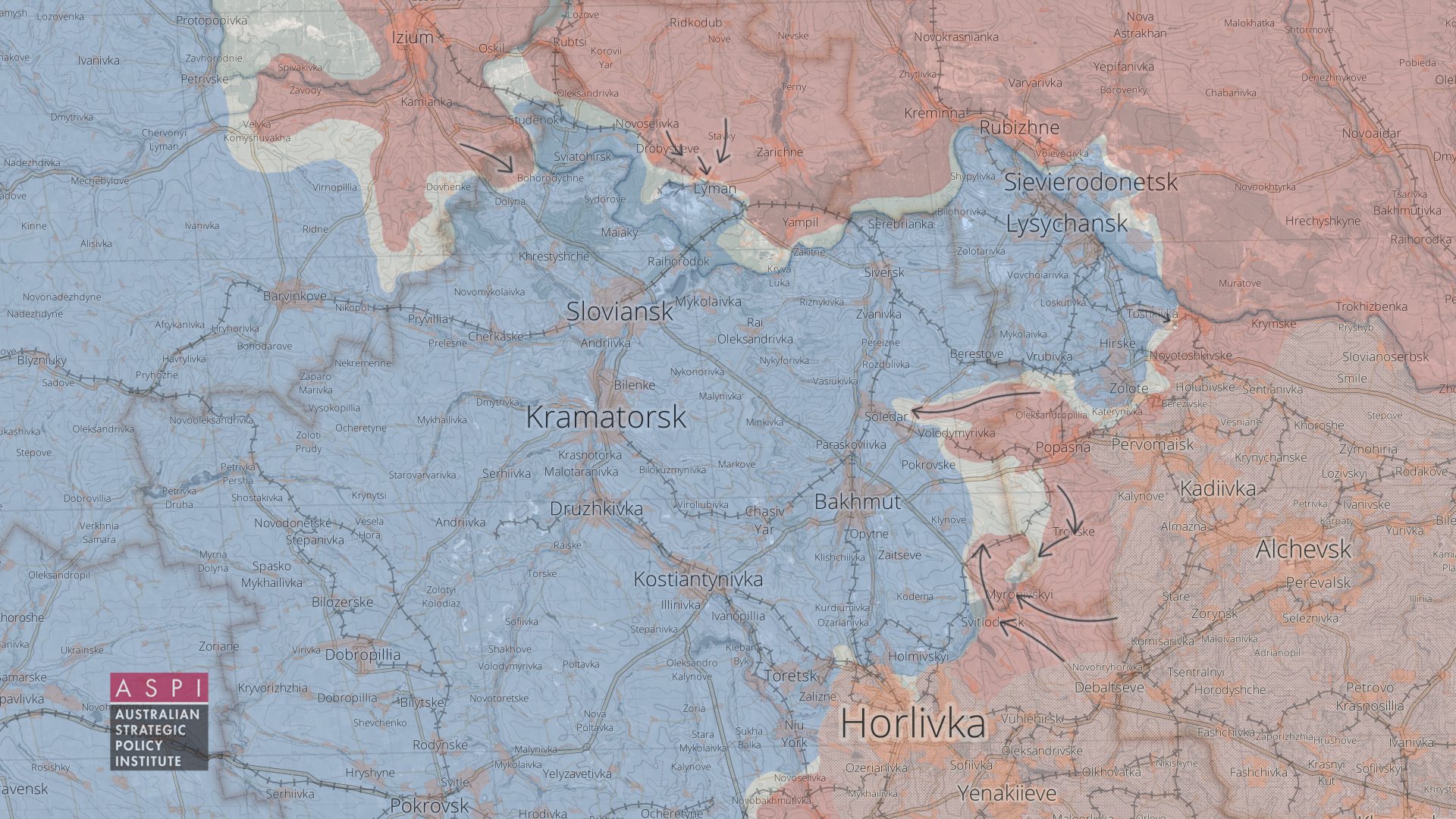
In Luhansk Oblast, the Russian troops continued to storm Sievierodonetsk on three sides. South of the city, there are battles for Toshkivka and Ustynivka. There is no encirclement of Ukrainian troops in Sievierodonetsk yet, but it is quite possible. Given the fall of Svitlodarsk, the Ukrainian troops would likely leave Sievierodonetsk soon to avoid being surrounded.
North of Popasna, no special Russian advance was recorded.
In Donetsk Oblast, the Ukrainian forces left Svitlodarsk to avoid encirclement in the area of the so-called Svitlodarsk bulge. The situation in nearby Luhanske isn’t clear yet, as the Russians said they’ve captured it, while Ukraine doesn’t confirm it.
https://twitter.com/War_Mapper/status/1529250950317228032
The Ukraine-controlled Donetsk suburbs of Avdiivka, Pisky and Mariinka were under fire and bombing. Russians claimed that they would no longer storm the Avdiivka fortified area, but would try to bypass it. Near Horlivka, the Russians continued their advancement attempts from Novobakhmutivka’s north towards New York.
No change or significant events in Zaporizhzhia, Mykolaiv and Kherson Oblasts.
Roman Ponomarenko’s 25 May morning update mentions that Russia has blocked the Bakhmut-Lysychansk highway in the area of Bilohorivka and Nahirne, making the threat of the encirclement of the Ukrainian forces in Sievierodonetsk and Lysychansk more than real.
Though, Russian troops need to advance not only from the south but also from the north. For that, Russia concentrates forces and prepares them to cross the Siverskyi Donets in the area of Yampil and near another Bilohorivka which is in the north.
However, Luhansk Oblast head Serhii Haidai denied the blockade of the highway saying that as of 13:00, May 25, the Lysychansk-Bakhmut route wasn’t blocked.
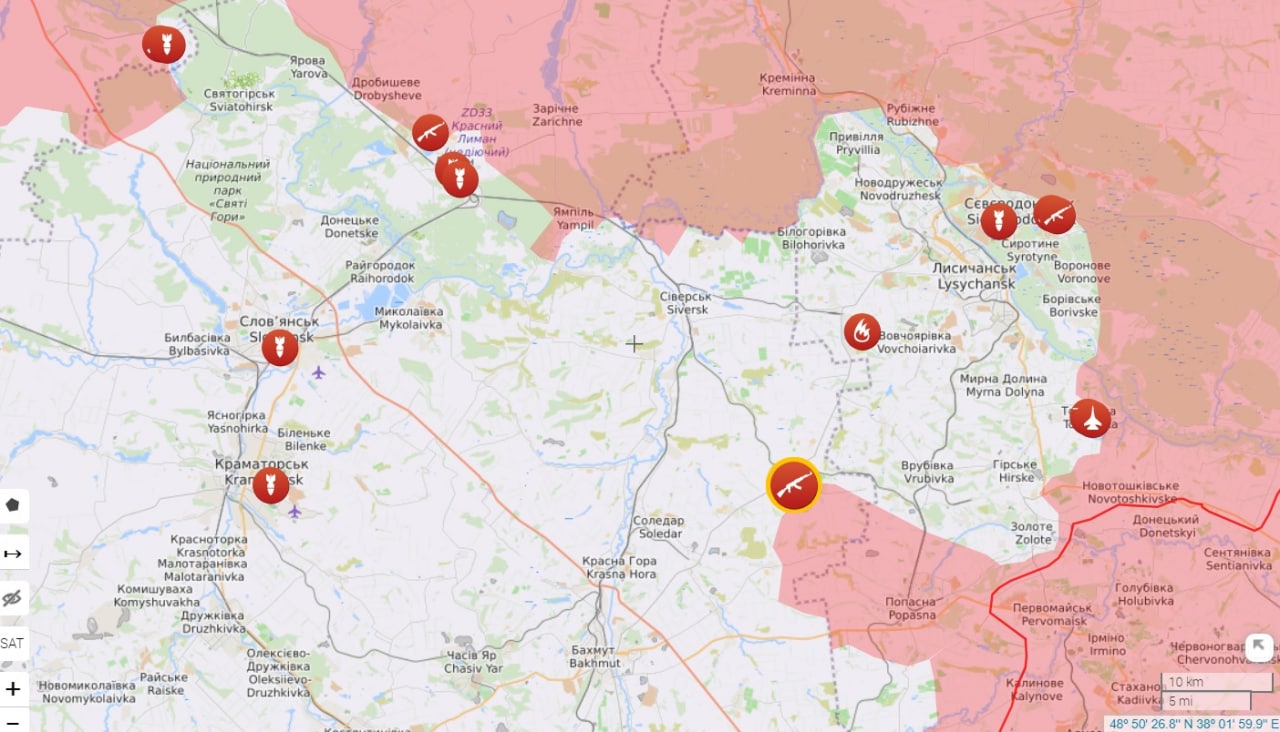
Morning report day 91 – May 25
The report is based on media reports, expert analyses and official information posted online.
Information from the General Staff as of 06.00 25.05.2022, supplemented by its [18:00 assessment] is in the drop-down box below.
In the Volyn and Polissia directions, up to seven battalions of the Armed Forces of the Republic of Belarus continue to carry out tasks to strengthen the protection of the Belarusian-Ukrainian border. The threat of the enemy’s missiles and airstrikes from the territory of the Republic of Belarus has not passed.
In the Siverskyi direction, Russian forces continue to strengthen the cover of the Ukrainian-Russian border, equipping strongholds in border areas in the Bryansk region. Russian occupiers continued artillery and mortar shelling of the positions of the Defense Forces and civilian infrastructure in the Sumy region from the territory of the Russian Federation.
In the Slobozhanskyi direction, Russian forces’ main efforts are focused on maintaining the occupied positions. It fired artillery at civilian infrastructure near the village of Rubizhne. In addition, the enemy made another attempt to conduct offensive operations in the direction of Ternova, but was unsuccessful.
- [In the Kharkiv direction, the Russian forces did not take active action yesterday, conducted reconnaissance and carried out measures to create favourable conditions for the resumption of the offensive. It carried out artillery shelling of units of the Defense Forces in the area of the village of Tsirkuny. The Russian forces also carried out a “Reconnaissance Strike” near the settlement of Apiary, suffered losses and withdrew.]
- In the Sloviansk direction, Russian forces units did not take active action, concentrating their main efforts on maintaining their positions, conducting reconnaissance and creating conditions for the resumption of the offensive. Shells from artillery and MLRS, mortars and tanks were recorded in the area of the settlements of Sviatohirsk and Dovhenke. Russian forces also launched an airstrike near the village of Bayrak.
- With the support of artillery and army aircraft, Russian forces tried unsuccessfully to take control of the village of Pasyka.
[In the Donetsk direction, Russian forces continue to conduct active offensive operations, trying to break through the defenses of our troops and reach the administrative borders of Luhansk Oblast. Yesterday, the Russian forces launched airstrikes on civilian infrastructure in the settlements of Kramatorsk, Lyman and Sloviansk.]
- In the Lyman direction, the enemy intensified hostilities. With artillery and air support conducts hostilities in the area of the village of Lyman.
- In the Sievierodonetsk direction, with the support of artillery fire, the Russian occupiers are conducting an offensive in the direction of the settlement of Sievierodonetsk and fighting continues.
- In the Bakhmut direction, Russian forces conducted offensive operations in the area of Komyshuvakha, Yakovlivka, and Troitsky, but had no success and suffered losses. [Yesterday, the Russian forces were advancing in the areas of the settlements of Lypove and Bilohorovka.]
- In the Avdiivka direction, Russian forces do not stop mortar and artillery shelling of the positions of the Defense Forces and civilian infrastructure in the areas of the settlements of Avdiivka, Pisky, Mariinka, Orikhove, and Novosilka. It used assault and army aircraft in the areas of Kamianka, Avdiivka, and Novomykhailivka.
- [In the Kurakhove, Novopavlivka, and Zaporizhzhia directions, yesterday the occupiers carried out attacks with assault and army aircraft. At the same time, the Russian forces do not stop mortar and artillery shelling of the positions of the Defense Forces and civilian infrastructure in the areas of Avdiivka, Pisky, and Mariinka.]
- Over the past 24 hours, nine attacks by Russian invaders were repulsed in Donetsk and Luhansk, three tanks, eight artillery systems, eighteen units of armored combat vehicles, a special armored vehicle and one unit of other vehicles were destroyed.
Russian forces did not conduct active hostilities in the Pivdennyi Buh direction. He fired on units of our troops and waged a counter-battery struggle. Conducted engineering activities for the main roads and bridges. [Yesterday, they inflicted an airstrike near the settlement of Mykolajivka.]
- [In the temporarily occupied territory of the Autonomous Republic of Crimea, the Russian forces are forming reserve units to conduct hostilities on the territory of Ukraine.]
To conduct hostilities and replenish significant losses of manpower and equipment on the territory of Ukraine, the Russian occupiers are forming reserve units from the Southern Military District.
Air defense units destroyed six Orlan-10 UAVs and one ZALA operational-tactical unmanned aerial vehicle in this direction.
[The occupiers continue to violate the rights of Ukrainian citizens in the temporarily occupied territories – they hinder free movement and create artificial conditions for the development of the humanitarian crisis.]”
Donetsk region: occupying forces capture Svitlodarsk, the Ukrainska Pravda reports. On the morning of 24 May, Russian forces entered Svitlodarsk, Donetsk Oblast and hung up a Russian tricolor over the city administration building, Vilne (Free) Radio citing the head of the Svitlodarsk military administration, Serhii Hoshko, reported.
Mykolaiv Oblast: Russian soldiers wearing Ukrainian military uniforms attempt to capture a Ukrainian observation post, the Ukrainska Pravda reports. “In the northeast of Mykolaiv Oblast, on the Kryvyi Rih front, there was a confrontation between our unit with a specific group of enemy forces. Supported by two Tigr armored combat vehicles and mortar fire, the enemy attempted to capture our observation post. The Ruscists were wearing Ukrainian Armed Forces military uniforms, Operational Command South claimed. The attack was repulsed and the enemy retreated, having lost four of its soldiers.”
Zaporizhzhia Oblast: Ukrainian collaborators with Russia talk about the possibility of acceding to Russia, the Ukrainska Pravda reports. Vladimir Rogov, a so-called “representative of the local administration” of Zaporizhzhia Oblast, claimed that Zaporizhzhia Oblast wants to be part of the Russian Federation. He was cited in the Kremlin-aligned Russian news agency RIA Novosti.
Russian Defence Minister Shoigu claim that Russia is slowing down the offensive in Ukraine on purpose, the Ukrainska Pravda reports, citing the Russian propaganda publication RIA Novosti. Russian Defence Minister Sergei Shoigu has claimed that “Russia is allegedly slowing down the pace of the offensive in Ukraine to avoid civilian casualties and allow people to evacuate. Ceasefires are announced and humanitarian corridors are being created to evacuate residents from the surrounding settlements. He also lied again to CSTO members that Russian troops allegedly did not strike at civilian infrastructure where civilians could be present.
Russia’s defense minister repeated the phrase that NATO has turned Ukraine into a state hostile to Russia, making it an instrument of pressure on Moscow; he told tales about the alleged network of more than 30 US bio laboratories in Ukraine and the alleged real threat of Ukraine’s creating a nuclear weapon.”
“We’re not chasing deadlines”: Chairman of the Russian Security Council on Putin’s goals and the war in Ukraine, the Ukrainska Pravda reports. Secretary of the Security Council of the Russian Federation Nikolai Patrushev said that Russia does not impose time limits on itself with regards to the war against Ukraine, that NATO countries are allegedly interested in a protracted war and that Russia has the right to demand “reparations”, Nikolai Patrushev told in an interview with Russian newspaper Argumenty i fakty. “We’re not chasing deadlines. Nazism must either be eradicated 100%, or it will raise its head again in a few years, in an even uglier form. All the goals set by the President of Russia will be reached. It can’t be otherwise, because the truth, especially historical truth, is on our side.”
According to British Defence Intelligence, (last 24 hours):
- There has been no significant merchant shipping activity in or out of Odesa since the start of the war. Russia’s subsequent naval blockade of key Black Sea ports has deterred the commercial shipping industry from operating in the area.
- Ukraine’s overland export mechanisms are highly unlikely to substitute for the shortfall in shipping capacity caused by the Russian blockade. As a result, significant supplies of Ukrainian grain remain in storage unable to be exported.
- Fighting has already placed indirect pressure on global grain prices. While the threat of Russia’s naval blockade continues to deter access by commercial shipping to Ukrainian ports, the resulting supply shortfalls will further increase the price of many staple products.
https://twitter.com/EuromaidanPress/status/1529371687019589632
As of Wednesday 25 May, the approximate losses of weapons and military equipment of the Russian Armed Forces from the beginning of the war to the present day:
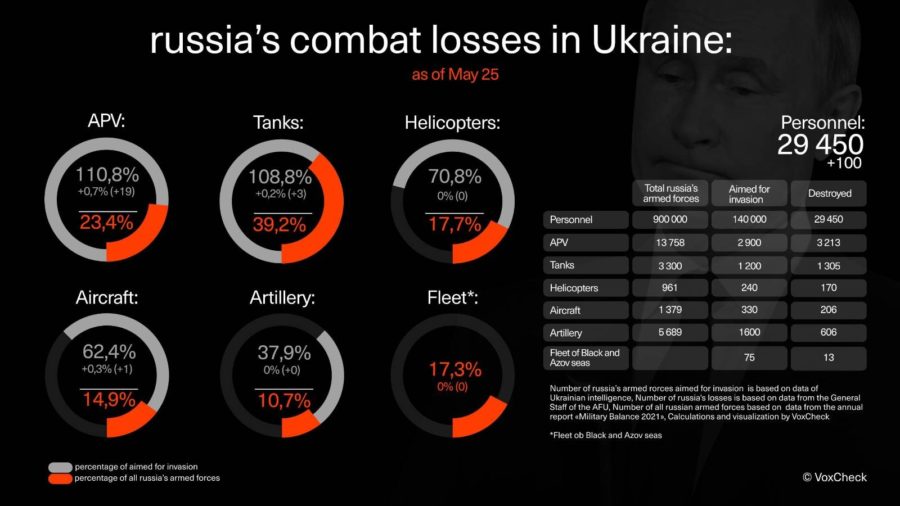
Russian enemy suffered the greatest losses (of the last day) in the Lyman direction.
Zelenskyy: Russia has 20 times more military equipment in Donbas than Ukraine, the Ukrainska Pravda reports. During a video call with the Ukrainian House in Davos, President Zelenskyy claimed that Russian troops have 20 times more military equipment in Donbas than the Ukrainian Armed Forces.
Russia’s “leading” 58th Army is destroyed in southern Ukraine – intercepted conversation, the Ukrainska Pravda reports citing the Security Service of Ukraine. According to an intercepted conversation of a Russian serviceman, Russia’s 58th Army, which the aggressors themselves called one of their leading armies, was completely destroyed.
Humanitarian
Half of Kherson’s population has left the region – head of the Kherson regional military administration, the Ukrainska Pravda reports. “The head of the Kherson regional military administration, Henadiy Lahuta, claimed that 50% of the population had left the region because people are not willing to live under occupation. The occupiers and collaborators are not letting people out. [They want] someone to ‘work with.’”.
According to UNHCR 6,595,675 refugees have been registered as of May 23. The UN says that so far Poland has taken in 3,524,205 refugees, Romania 966,490, Russian Federation 932,220, Hungary 649,352, Republic of Moldova 472,377, Slovakia 444,368 and Belarus 27,308. Among those who fled Ukraine are also Ukrainian nationals with dual citizenship. An additional 105,000 people moved to the Russian Federation from Donetsk and Luhansk oblasts between 18 and 23 February.
The number of Ukrainians entering Ukraine since February 28 is 2,086,500 as of May 23. This figure reflects cross-border movements, which can be pendular and does not necessarily indicate sustainable returns.
OHCHR recorded 8,533 civilian casualties in Ukraine as of May 23. 3,942 were killed (including 258 children) and 4,591 injured (including 399 children).
Environmental
The food crisis fuels fears of protectionism compounding shortages, the Reuters reports. A growing world food crisis is precipitating protectionist moves by countries which are likely to compound the problem and could lead to a wider trade war, business leaders and policymakers at the World Economic Forum said.
“It is a major issue and frankly I think the problem is even bigger ahead of us than it is behind us,” Gita Gopinath, first deputy managing director of the International Monetary Fund, told Reuters of rising food security concerns.
“We were facing an extraordinary food crisis before Ukraine, food costs, commodity prices, shipping costs were already doubling, tripling, quadrupling,” David Beasley, Executive Director for the United Nations World Food Programme, said. The number of people “marching to starvation” has risen from 80 million to 276 million over the last four to five years, Beasley told Reuters in an interview in Davos. “To keep the ports closed as the harvest season is now coming in Ukraine in July and August, it means a declaration of war on global food supply,” he said.
World leaders called for action to release 20 million tons of Ukrainian grain trapped by a Russian naval blockade, The New York Times reports. A Russian blockade of Ukrainian seaports and attacks on its grain warehouses have choked off one of the world’s breadbaskets, deepening concern that President Vladimir V. Putin is using food as a powerful new weapon in his three-month-old war.
Some Western officials warned that unless the port of Odesa was opened soon, there was a threat of famine in some countries and political unrest in others, in what could be the gravest global repercussion yet of Russia’s assault on its neighbour.
Ursula von der Leyen, the president of the European Commission, accused Russia of confiscating Ukrainian grain stocks and agricultural machinery, bombarding grain warehouses and trapping Ukrainian cargo vessels laden with wheat and sunflower seeds in the Black Sea.“The consequences of these shameful acts are there for everyone to see,” she said at the World Economic Forum in Davos, Switzerland. “Global wheat prices are skyrocketing and it is fragile countries and vulnerable populations that suffer most.”
The European Union, she said, was working to open alternative routes for shipments overland linking Ukraine’s borders to European ports. Among the proposals was for a flotilla escorted by vessels from non-NATO countries to break the Russian blockade off Odesa and escort Ukrainian cargo ships. But doing so would risk a wider confrontation with Russia, an escalation the West has been trying to avoid.
“It’s a perfect storm within a perfect storm,” said David Beasley, the executive director of the World Food Program, a United Nations agency. “If we don’t get the port of Odesa open, it will compound our problems.” Calling the situation “absolutely critical,” he warned, “We will have famines around the world.”
Harsh Winter Could Force Europe to Ration Gas, Global Energy Leader Warns, The New York Times reports. “Fatih Birol, the executive director of the International Energy Agency, said Tuesday that he was warning leaders in Europe to create backup plans in case harsh winter weather forced countries to conserve natural gas.
I’m afraid that I cannot exclude the risk this winter that we are facing rationing of gas, Mr. Birol said during an interview at the World Economic Forum, the annual gathering of global business leaders in Davos, Switzerland. I’m advising several European governments to prepare a contingency plan. Before the invasion of Ukraine, Russia provided nearly 40 percent of the European Union’s gas supply and 55 percent of Germany’s. Europe is paying for its over-dependence on Russian energy, Mr. Birol said.”
Legal
Russians shell Sloviansk with cluster bombs, the Ukrainska Pravda reports. According to Vadim Lyakh, the Head of the Sloviansk City Civil-Military Administration, Russian troops shelled the city of Sloviansk in the Donetsk region with cluster shells on Tuesday, but fortunately, no one was injured.
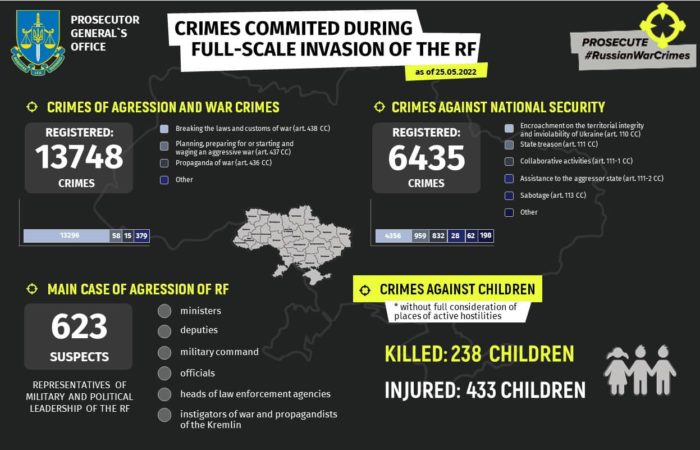 238 children were killed and 433 children injured, the Office of the Prosecutor General of Ukraine reports as of May 25. 1,848 educational establishments are damaged as a result of shelling and bombings, 173 of them are destroyed fully. 13,748 crimes of aggression and war crimes and 6,435 crimes against national security were registered.
238 children were killed and 433 children injured, the Office of the Prosecutor General of Ukraine reports as of May 25. 1,848 educational establishments are damaged as a result of shelling and bombings, 173 of them are destroyed fully. 13,748 crimes of aggression and war crimes and 6,435 crimes against national security were registered.
Support
Ukraine repeats its call for MLRS support. Multiple launch rocket systems (MLRS) can help Ukraine repel the Russian offensive, thwart their occupation plans, end torture and prevent a food crisis, the Ukrainian Foreign Minister Dmytro Kuleba said on Twitter, Ukrinform reports.
“Four letters can help Ukraine repel Russian offensive in the Donbas, foil Russian plans to annex Kherson, stop Russian torture, rape and other horrific human rights abuses in the occupied territories, unblock exports and avert global food crisis. These four letters are MLRS, Kuleba said.”
Zaluzhnyi: Caesar howitzers are already on the front line, use mastered in 2-3 hours, the Ukrainska Pravda reports. The Commander-in-Chief of the Armed Forces of Ukraine, Valerii Zaluzhnyi, has shared photos of Caesar self-propelled artillery units provided by partners, which have already been used on the front line.
“Caesar howitzers are already on the front line. Our gunners quickly mastered the new self-propelled guns, in just 2-3 hours in fact. I am sincerely grateful to our partners for their help! It contributes to bringing our Victory closer.”
https://twitter.com/EuromaidanPress/status/1529190504964861952
EU summit unlikely to find a solution on Russia oil embargo, von der Leyen says, the Reuters reports.
“European Union leaders are unlikely to strike a deal on an oil embargo against Russia at their summit on Monday and Tuesday, head of the bloc’s executive Ursula von der Leyen said. Von der Leyen’s Commission has proposed phasing out Russian oil imports by the end of the year in most EU member states, while Hungary and others could be given more time. It would be the EU’s harshest sanction yet in response to Moscow’s Feb. 24 invasion of Ukraine. Hungary, however, has so far refused to lift its veto.”
New developments
- Aggressors will have to leave Crimea – Zelenskyy, the Ukrainska Pravda reports. “Of course, the aggressors will have to leave Crimea, too. As well as Kherson, Melitopol, Enerhodar, Mariupol and all other cities and communities where they still pretend to be the masters. They will definitely not be the masters there,” the President said in a video address. Volodymyr Zelenskyy reminded listeners that the Russian invasion of Ukraine in 2014 started in Crimea.
- The US will start blocking Russia’s bond payments to American investors, The New York Times reports. “The Biden administration will start blocking Russia from paying American bondholders, increasing the likelihood of the first default of Russia’s foreign debt in more than a century. An exemption to the sweeping sanctions that the United States imposed on Russia as punishment for its invasion of Ukraine has allowed Moscow to keep paying its debts since February. But that carve-out will expire on Wednesday and the United States will not extend it, according to a notice published by the Treasury Department on Tuesday. As a result, Russia will be unable to make billions of dollars of debt and interest payments on bonds held by foreign investors”.
- Russian parliament passes a bill allowing Moscow to close Western news bureaus, the Reuters reports. “Russia’s parliament on Tuesday passed a bill giving prosecutors powers to shut foreign media bureaus in Moscow if a Western country has been “unfriendly” to Russian media, following the closure of some Russian state news outlets in the West. The journalists of a media organisation deemed to be an offender under the bill would have their foreign ministry accreditation withdrawn – meaning they could not work in Russia. The new bill adds to the challenges facing foreign media after Russia in March adopted a law which penalized what it termed spreading “fake” news about its army. It needs to undergo two more readings, be reviewed by the upper house of parliament and signed by President Vladimir Putin to become law”.
- Ukrainians are not prepared to give up any land. A poll by the Kyiv International Institute of Sociology found that 82 percent of Ukrainians are not prepared to give up any land, even if it means the war continues. Only 10 percent said they believed that giving up land was worth ending the conflict. 8 percent were undecided.
Assessment
On the War
The Institute for the Study of War has made the following assessment as of Tuesday 24 May:

Russian forces will additionally likely face protracted urban combat if they successfully encircle Sievierodonetsk (as well as in other large towns like Bakhmut), which Russian forces have struggled with throughout the war. Russian forces are committing a significant number of their troops, artillery and aircraft to defeat Ukrainian defenders in Luhansk Oblast and are likely pulling necessary resources from the Izium axis, defensive positions around Kharkiv City, Donetsk City and the Zaporizhzhia area. Luhansk Oblast Administration Head Serhii Haidai has previously compared Ukrainian forces in Luhansk Oblast to the previous defenders of Mariupol, which aimed to wear out Russian forces and prevent further offensive operations. The UK Defense Ministry also noted that a Russian victory over Sievierodonetsk will only worsen Russian logistical issues and extend Russian ground lines of communication (GLOCs). Russian forces are making greater advances in the past week than throughout the rest of May—but these advances remain slow, confined to smaller objectives than the Kremlin intended and face continued Ukrainian defenses; they do not constitute a major breakthrough.
Senior Kremlin officials are increasingly openly admitting that the Russian offensive in Ukraine is moving slower than anticipated and are grasping for explanations to justify the slow pace. Russian Defense Minister Sergey Shoigu claimed that Russian operations in Ukraine are progressing slowly because Russian forces want to afford civilians the opportunity to evacuate, though Russian forces have targeted Ukrainian civilians throughout the war and repeatedly denied Ukrainian attempts to negotiate humanitarian evacuation corridors. Shoigu’s statement is notably his first admission that Russian forces are behind schedule and is the first official statement on the pace of the war since Belarusian President Alexander Lukashenko stated that the operation was “dragging” on May 4. Russian milbloggers are criticizing Shoigu’s claimed consideration for civilians and claimed that Soviet troops would not have cared if “Nazi” civilians evacuated, part of the growing Russian nationalist reaction that the Kremlin is not doing enough to win the war in Ukraine. Director of the Russian Foreign Intelligence Service Sergey Naryshkin stated that the ultimate goal of the Russian offensive is to ensure “Nazism” is “100% eradicated, or it will rear its head in a few years and in an even uglier form.” Naryshkin and Shoigu’s statements indicate that Russian officials are likely setting conditions for a protracted war in Ukraine in order to justify slower and more measured advances than initially anticipated.
Forcefully mobilized servicemen from the Donetsk and Luhansk “People’s Republics” continued to protest the Russian and proxy military command. Servicemen of the 3rd Infantry Battalion of the 105th Infantry Regiment from the Donetsk People’s Republic (DNR) recorded a video appeal to DNR Head Denis Pushilin wherein they claimed they were mobilized on February 23 and that they have been forced to actively participate in hostilities despite their lack of military experience. The battalion stated that they served on the frontlines in Mariupol and have been redeployed to the territory of the Luhansk People’s Republic (LNR) with only 60% of their original personnel and are now dealing with severe morale issues and physical exhaustion. The battalion notably claimed that the servicemen did not go through routine medical inspection prior to service and that many are suffering from chronic illnesses that should have rendered them ineligible for service. The video appeal is consistent with numerous reports from Ukrainian and Western sources that proxy forces are largely forcibly mobilized, poorly trained and suffering from declining morale, but is notable due to the willingness of the DNR servicemen to publicly express their discontent.
Key Takeaways
- Russian forces have likely abandoned efforts to encircle large Ukrainian formations in eastern Ukraine and are instead attempting to secure smaller encirclements and focus on Sievierodonetsk.
- This change in the Russian approach is enabling gradual advances—but at the cost of abandoning several intended lines of advance and abandoning the Kremlin’s intended deep encirclement of Ukrainian forces in eastern Ukraine.
- Ukrainian forces are likely conducting a controlled withdrawal southwest of Popasna near Bakhmut to protect Ukrainian supply lines against Russian offensives in the southeast of Bakhmut.
- Russian occupation authorities in Mariupol announced that they will hold war crimes trials against Ukrainian soldiers in Mariupol in a likely effort to strengthen judicial control of the city and support false Kremlin narratives of Ukrainian crimes.
- Russian forces are attempting to retake Ternova in northern Kharkiv Oblast and seek to stabilize defensive positions near the Russian border against the Ukrainian counteroffensive.
- Russian forces are forming reserves and deploying S-400 missile systems in northwest Crimea to reinforce the southern axis.
- Several DNR servicemen openly released a video appeal to DNR leader Denis Pushilin stating they have been forced into combat operations without proper support, indicating increasing demoralization among Russian and proxy forces.“
US intelligence document shows Russian naval blockade of Ukraine, The Washington Post reports. “Newly declassified US intelligence shows that a Russian naval blockade has halted maritime trade at Ukrainian ports, in what world leaders call a deliberate attack on the global food supply chain that has raised fears of political instability and shortages unless grain and other essential agricultural products are allowed to flow freely from Ukraine.

Russia’s navy now effectively controls all traffic in the northern third of the Black Sea, making it unsafe for commercial shipping, according to a US government document obtained by The Washington Post.
The document, based on recently declassified intelligence, analyzed the density of Russian naval activity along portions of Ukraine’s southern coast and the Crimean Peninsula, which Russia occupied and annexed in 2014. The blockade that ensued following Russia’s invasion in February halted civil maritime traffic, “entrapping Ukrainian agricultural exports and jeopardizing global food supplies,” according to a US official, who spoke on the condition of anonymity to describe the intelligence.
“The impact of Russia’s actions cannot be understated as Ukraine’s seaborne exports are vital to global food security,” the official stated. “Ukraine provides about 10 percent of the world’s wheat exports and the vast majority of those exports — approximately 95 percent in 2020 — departed via Black Sea ports.”
In recent days, world leaders have warned that Russia’s blockade poses one of the most dire threats to global stability since the war began. Ukraine is a global food basket. The country is the world’s largest exporter of sunflower oil, the fourth largest exporter of corn and the fifth largest exporter of wheat.
Speaking at the World Economic Forum in Davos, Switzerland, on Tuesday, European Commission President Ursula von der Leyen said that 20 million tons of wheat are struck in Ukraine. Russia has deliberately bombed Ukrainian grain warehouses and is “hoarding its own food exports as a form of blackmail,” she said, “holding back supplies to increase global prices, or trading wheat in exchange for political support. This is using hunger and grain to wield power.”
Politically fragile countries are especially vulnerable, von der Leyen said, noting that bread prices in Lebanon have increased by 70 percent and food shipments from Odesa to Somalia have stopped because of Russia’s actions.
Secretary of State Antony Blinken echoed the grim assessment last week in remarks at the United Nations, calling Russia’s blockade “a deliberate effort” to destabilize the world’s food supply.
Since Russia issued a warning to mariners in February that significant areas of the Black Sea were closed to commercial traffic, “the Russian military has repeatedly blocked safe passage to and from Ukraine by closing the Kerch Strait, tightening its control over the Sea of Azov, stationing warships off Ukrainian ports. And Russia has struck Ukrainian ports multiple times,” Blinken said.
“The food supply for millions of Ukrainians — and millions more around the world — has quite literally been held hostage by the Russian military,” he said.
For weeks, Ukrainian President Volodymyr Zelenskyy has called on Western powers to break the blockade. […] But Western powers have few options for ending the Russian blockade.
The United States has no vessels in the Black Sea, Gen. Mark A. Milley, the chairman of the Joint Chiefs of Staff, told reporters at a news conference at the Pentagon on Monday. The Biden administration has steadfastly resisted any direct military involvement in the war. […]
The European Commission has proposed exporting Ukraine’s wheat and other grains by rail, road or by river. But it’s unclear how allied forces could protect those shipments from Russian assault. […]
“Even before Russia’s full-scale invasion of Ukraine, 2022 was forecast to be the most food-insecure year on record globally, making supply from Ukraine even more critical,” Michael Carpenter, the US ambassador to the Organization for Security and Cooperation in Europe, said in remarks last week in Vienna. Carpenter cited Ukrainian government reports that Russian forces had stolen 400,000 tons of Ukrainian wheat, as well as farm equipment, which was shipped back to Russian territory. He said Russian forces had also destroyed roads, railways and rail stations needed to transport products for export, in addition to its blockade of sea ports.
“As a result of Russia’s aggression, global food shortages are increasing and food prices are rising, exacerbating suffering and hardship for millions of vulnerable people across the globe,” Carpenter said, noting a World Food Program estimate that the war could drive 47 million additional people worldwide “into acute food insecurity.” […]
Putin needs the whole of Ukraine, he is not interested in only a part, the Head of the Defence Intelligence of Ukraine (DIU), Major General Kyrylo Budanov, says. “The general idea has not changed: Putin needs the whole of Ukraine, he is not interested in any part. Of course, after three months of events, they are adjusting their plans and preparing public opinion in Russia for the fact that, in principle, if they end the occupation of Donetsk, Luhansk and Kherson regions, it can also be considered a victory. However, the plans have not changed and, unfortunately, will not change until we put an end to the issue of Putin and Russia as it exists today – the threat to the whole world, especially the European continent, will continue. said the head of the domestic military intelligence about the plans of the Kremlin leadership”.
Ukraine’s intelligence chief: a hidden coup is possible in Russia, but not an open one, the Ukrainska Pravda reports. Ukrainian intelligence considers an open coup d’état in Russia unrealistic, but according to its information, President Vladimir Putin’s entourage is looking for a replacement.
“The inner circle, which is now, so to speak, the financial branch, has lost quite a lot because of the war. And so they are looking for a way out of the situation. The easiest way out of the situation for them is to replace Putin with someone else. Let’s just say, to blame all the problems not on Russia, but on one person – Putin. And to say that he was a sick dictator, to ask for all the sanctions and all the restrictions to be lifted and start afresh, it’s not Russia’s fault, but his… A coup d’état? An open one is unrealistic. But a hidden one, yes. A hidden coup is possible.”
According to Budanov, the majority of the Russian military is in favour of the war. However, they are not too eager to continue the fighting, given the significant losses.
As for Russia’s special services, a number of them initially advocated this “operation” to cover up the huge waste [of money] that has been spent for many years to build up so-called pro-Russian people in Ukraine. In addition, they firmly believed that they would take Kyiv in three days and would complete the entire military operation in Ukraine on day 10. That was their dream. But it failed.
Russian business, on the other hand, clearly understands what it has lost and is therefore trying to find a way out and somehow end the war. This is a rather pragmatic approach to the war. “They are losing money and it’s a lot of money. So they oppose it. However, they do not dare to openly talk about this with Putin. They have these sorts of conversations amongst themselves. Conversations like these are going on even between business and the security forces, between business and politicians. It’s all there”, Budanov said.”
Ukraine’s intelligence chief: Putin has several illnesses, but he still has a few more years left, the Ukrainska Pravda reports. “Yes, we fully confirm this information (that Putin has cancer – ed.). He has several serious illnesses, one of which is cancer. But it’s not worth hoping that Putin will die tomorrow. He still has at least a few years left. Whether we like it or not, that’s the truth.”
Sailors of the Caspian flotilla of the Russian Federation refuse to perform combat missions due to the state of emergency of ships, the DIU claims. The international sanctions imposed against the occupying country do not allow for proper maintenance of the fleet’s warships. Chinese-made parts, which have been purchased at an inflated price, have been installed instead of the originals.
Sailors of the 106th brigade of surface ships of the Caspian flotilla of the Southern Military District of the Russian Federation, which is part of a naval group involved in the war against Ukraine, refuse to perform combat missions due to the emergency condition of the ships. The occupiers decided to secretly write collective letters to Putin and the Shoigu, in which to reveal the financial conspiracies of the command.
The DIU publishes a list of war criminals – servicemen of the 106th Brigade of surface ships (unit 40153 Kaspiysk).
Hans Petter Midttun’s assessment
A former colleague has accused me of being irresponsible for arguing that NATO should execute an UN-mandated humanitarian intervention in Ukraine, enforce a No-Fly Zone over its airspace and break the Russian blockade of the Ukrainian ports. He fears this would lead to an escalation of the war and a confrontation between Russia and the Alliance. He is voicing what seems to be a concern of many in the West.
The idea that NATO’s military engagement in and over Ukraine will trigger a World War 3 and a nuclear confrontation has apparently become a mantra guiding our collective actions. Hypothetical and in my humble opinion, highly unlikely consequences are stopping us from acting on real, fundamental and far-reaching global challenges.
I have previously argued that we already are locked in a wider confrontation with the Russian Federation. Ukraine is only an object and not the strategic aim of the Hybrid War. It is a conflict between Russia and the West over the world order and the conflicting ideas of the authoritarian “Russian World” and the Western liberal democracies. A Russian victory in Ukraine is, however, a prerequisite for its global ambitions.
This has been repeatedly confirmed by Russian actions and statements. President Putin’s ultimatum to the USA and NATO as of 15 December 2021 is a chilling reminder of the state of affairs. Lately, it has repeatedly claimed that the West is waging a total (hybrid war), economic, information and cultural war against Russia. Sanctions are described as an act of aggression. It claims (falsely) that the West is responsible for the war in Ukraine. The Western support for Ukraine makes it also a party to the war. According to Lavrov, NATO is “in essence, engaged in a war with Russia through a proxy and is arming that proxy.”
The current Russian regime is threatening peace and security in Europe. The European Parliament has listed a chillingly, long and comprehensive list of the Russian aggressions and has formally acknowledged the anti-Western vector of the Russian foreign policy underlining the fundamental and systemic incompatibility of the socio-political systems of Russia and the West. It acknowledges that Russia is trying to destabilize the EU and its Member States through hybrid warfare.
I have also repeatedly argued that the main battlespace of the more than 8 year-long Russian Hybrid War occurs inside the cognitive spaces of populations and key decision- and policymakers. Using war, disinformation, cyber-attacks, blackmail, provocations, fabrications, military deceptions and other active measures, it creates a virtual reality that prompts the West into making the political decisions Russia wants without suspecting (or acknowledging) they are being manipulated.
Both ambiguities and the duality between the threat of military escalation and the hope of a peaceful resolution are used to complicate or undermine the decision-making processes making a military response – or even a political response – difficult. The Russian strategy for more than 8 years has revolved around the need to avoid a confrontation with the West.
And it is still succeeding in doing just that. Hypothetical consequences are stopping us from acting on real, fundamental global challenges.
NATO and its 30 member states are being deterred by Russia, the very same country the Alliance itself is designed and tasked to deter. The long-term consequences of the Alliance’s failure to act according to its strategic concept and defend international law and security are hard to predict.
In my opinion, not responding resolutely to the very real, fundamental and far-reaching global challenges caused by the Russian war in Ukraine is grossly irresponsible.
I will, therefore, challenge those who claim that an UN-mandated humanitarian intervention will trigger a WW3 and a nuclear confrontation to outline why this is a more attractive alternative to the Russian Federation than a military withdrawal from Ukraine. Especially in light of its massive military losses and the many fundamental and structural challenges the 3 months of war have uncovered in the Russian Armed Forces.
Please, tell us why Russia would choose to fight 31 when it is struggling to fight 1.




